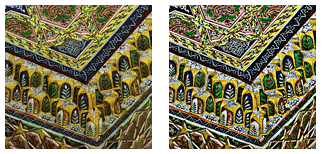Sharpening techniques can be used to achieve significant improvements in images in soft images. However, it is important to understand from the outset that the amount of information contained within an image cannot be increased. Existing information can nevertheless be made to work more effectively. This is most easily demonstrated where strong, well-defined patterns dominate. Edges can be rendered clearer and better-defined by increasing local contrast.
Image sharpness is not as easy to assess on a computer monitor as one might expect. In most cases the image presented on a screen is interpolated in some way and its sharpness is therefore compromised. True image sharpness is therefore impossible to assess unless the image is viewed at actual pixel level (View - actual pixels). This means that each pixel in the image is represented by a single pixel on the monitor. Interpolation is then unnecessary.
 Unsharp masking is perhaps the most versatile and commonly used of the sharpening techniques. It increases edge definition without introducing unwanted artifacts such as bright halos into an image, but must be used carefully and not overdone. Over-sharpening is arguably worse than softness in an image. Correct adjustment of the settings used for unsharp masking, known as "amount", "radius" and "threshold", is therefore vitally important. Images being prepared for printing should be sharpened somewhat more than those intended for on-screen use. They can be sharpened to the point where the first signs of artifacts are visible because the printing process tends to soften the image to some extent. Images intended for on-screen use should not be sharpened to the point where artifacts become visible because these will be seen when the image is viewed.
Unsharp masking is perhaps the most versatile and commonly used of the sharpening techniques. It increases edge definition without introducing unwanted artifacts such as bright halos into an image, but must be used carefully and not overdone. Over-sharpening is arguably worse than softness in an image. Correct adjustment of the settings used for unsharp masking, known as "amount", "radius" and "threshold", is therefore vitally important. Images being prepared for printing should be sharpened somewhat more than those intended for on-screen use. They can be sharpened to the point where the first signs of artifacts are visible because the printing process tends to soften the image to some extent. Images intended for on-screen use should not be sharpened to the point where artifacts become visible because these will be seen when the image is viewed.
The unsharp masking process essentially looks for pixels within an image which are significantly different from adjacent pixels. the contrast between these pixels and their surrounding pixels is then increased. This enhances the impression of clearer, better-defined edges although the process does not actually look for edges in an image in the manner of many other sharpening tools. Sharpening is generally best done as the final stage of image manipulation, except perhaps for combining layers. However the resulting increase in contrast may also reveal previously unnoticed dust spots and defects which require another round of minor editing.
In the left-hand image the contrast is lower and the edges within the pattern are poorly defined. In the right-hand image, which has been sharpened to a considerable extent, the contrast is greater and the pattern is consequently clearer and better-defined.
The "amount" slider in Photoshop's unsharp mask determines the intensity of the sharpening process. The higher the percentage set on the slider, the greater the sharpening effect applied. The correct setting must be determined by experience and will vary with the nature of the subject matter. However, it is generally best to start somewhere in the range 150% to 200%. The "radius" setting controls the radius or spread of the sharpening process and will again depend upon the subject matter and the size of the final image. Start with the slider set between minimum and 2 and notice that edges are emphasized to a greater extent as the radius increases. The "threshold" setting determines which pixels are chosen for sharpening based upon the difference between their brightness and that of the surrounding pixels. At high threshold settings, only neighbouring pixels are affected. At lower settings many more pixels are sharpened. For example, if two adjacent pixels have values of 128 and 138, and the threshold is set to 4, they will be affected because their tonal difference is greater than the threshold value.
The best approach to unsharp masking is often selective. Select or mask off areas of an image which should be protected from sharpening, or those which require sharpening, and work specifically on the relevant area before moving on to other parts of the image. Duplicate layers can also be used to achieve selective results. Sharpen the duplicated layer for a particular area of an image without observing the effects elsewhere, and then selectively merge the layers using appropriate layer masks.
Other sharpening filters are too numerous to address individually and are known by names such as "edge sharpen", "smart sharpen" and "sharpen more". Each one uses a different algorithm to achieve effects which have application in particular situations and with particular subject matter.






